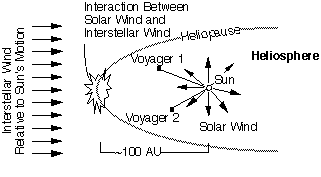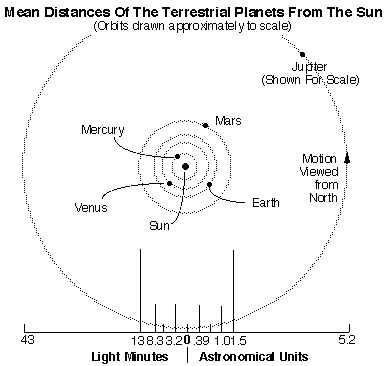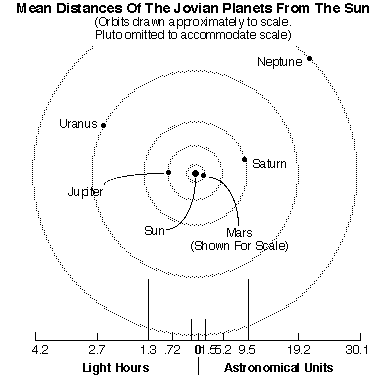 The Solar System
The Solar System
Sun and planets shown to scale.
(GIF, 93K;
TIF, 867K;
TIF with captions, 890K)
There are more things in heaven and earth, Horatio, than are
dreamt of in our philosophy. -Shakespeare

Table of Contents
Related Resources

- Formation of the Solar System -
AVI, 3M.

Our
solar system consists of an average star we call the
Sun, the planets
Mercury, Venus,
Earth, Mars,
Jupiter, Saturn,
Uranus, Neptune, and
Pluto.
It includes the satellites of the planets,
numerous comets,
asteroids, meteoroids, and the interplanetary
medium. The Sun is the richest source of electromagnetic energy
(mostly in the form of heat and light) in the solar
system. The Sun's nearest known stellar neighbor is a
red dwarf star called Proxima Centauri, at a distance of 4.3
light years away. The whole solar
system, together with the local stars visible on a clear night,
orbits the center of our home galaxy, a spiral disk of 200 billion
stars we call the Milky Way. The Milky Way has two small
galaxies orbiting it nearby, which are visible from the southern
hemisphere. They are called the Large Magellanic Cloud and the
Small Magellanic Cloud.
The nearest large
Galaxy is the Andromeda Galaxy. It is a spiral galaxy like the Milky
Way but is 4 times as massive and is 2 million light years away.
Our galaxy, one of billions of galaxies
known, is traveling through intergalactic space.
The planets, most of the satellites of the planets and the
asteroids revolve around the Sun in the same direction,
in nearly circular orbits.
When looking down from above the Sun's north pole,
the planets orbit in a counter-clockwise direction.
The planets orbit the Sun in or near the same plane, called the
ecliptic. Pluto is a special
case in that its orbit is the most
highly inclined (18 degrees) and the most highly elliptical of all the
planets. Because of this, for part of its orbit, Pluto is closer
to the Sun than is Neptune. The axis of rotation for most of the planets
is nearly perpendicular to the ecliptic. The exceptions are
Uranus and Pluto
which are tipped on their sides.
The Sun contains 99.85% of all the matter in the Solar System.
The planets, which condensed out of the same disk of material
that formed the Sun, contain only 0.135% of the mass of the solar system.
Jupiter contains more than twice the matter of all the other planets
combined. Satellites of the planets, comets, asteroids, meteoroids,
and the interplanetary medium constitute the remaining 0.015%.
The following table is a list of the mass distribution within
our Solar System.
- Sun: 99.85%
- Planets: 0.135%
- Comets: 0.01% ?
- Satellites: 0.00005%
- Minor Planets: 0.0000002% ?
- Meteoroids: 0.0000001% ?
- Interplanetary Medium: 0.0000001% ?
Nearly all the solar system by volume appears to be an empty void.
Far from being nothingness, this vacuum of "space" comprises the
interplanetary medium. It includes various forms of energy and at
least two material components: interplanetary dust and interplanetary
gas. Interplanetary dust consists of microscopic solid particles.
Interplanetary gas is a tenuous flow of gas and charged particles,
mostly protons and electrons -- plasma
-- which stream from the Sun, called the
solar wind.
The solar wind can be measured by spacecraft, and it has a large effect
on comet tails. It also has a measurable effect on the motion of
spacecraft. The speed of the solar wind is about 400 km per second
in the vicinity of Earth's orbit. The point at which the solar wind
meets the interstellar medium, which is the "solar" wind from other
stars, is called the heliopause. It is a boundary theorized to be
roughly circular or teardrop-shaped, marking the edge of the Sun's
influence perhaps 100 AU from the Sun. The space within the boundary
of the heliopause, containing the Sun and solar system, is referred to
as the heliosphere.
The solar magnetic field extends outward into interplanetary space;
it can be measured on Earth and by spacecraft. The solar magnetic
field is the dominating magnetic field throughout the
interplanetary regions of the solar system, except in the immediate
environment of planets which have their own magnetic fields.
The terrestrial planets are the four innermost
planets in the solar system, Mercury, Venus, Earth and Mars. They are
called terrestrial because they have a compact, rocky surface like the
Earth's. The planets, Venus, Earth, and Mars have significant
atmospheres while Mercury has almost none. The above image shows to scale
the terrestrial planets Mercury, Venus, Earth and Mars. The
following diagram shows
the approximate distance of the terrestrial planets to the Sun.
Jupiter, Saturn, Uranus, and Neptune are known as the jovian
(Jupiter-like) planets, because they are all gigantic compared
with Earth, and they have a gaseous nature like Jupiter's.
The jovian planets are also referred to as the gas giants,
although some or all of them may have small solid cores.
The above image shows to scale the jovian planets Jupiter, Saturn,
Uranus and Neptune. The following diagram shows
the approximate distance of the jovian planets to the Sun.
The following table lists statistical information for the Sun and
planets:
Dist. -- Distance to the Sun in AU's.
Radius -- Radius in terms of the Earth's.
Mass -- Mass in terms of the Earth's.
Rotate -- Rotation rate in Earth days.
Sat. -- Number of associated satellites.
Incl. -- Orbital inclination in degrees.
Eccen. -- Orbital Eccentricity.
Density -- Density in g/cm^3.
Name Dist. Radius Mass Rot. Sat. Incl. Eccen. Density
--------------------------------------------------------------
Sun 0 109 332800 25-36* 9 --- --- 1.410
Mercury 0.39 0.38 0.05 58.8 0 7 0.2056 5.43
Venus 0.72 0.95 0.89 244 0 3.394 0.0068 5.25
Earth 1.0 1.00 1.00 1.00 1 0.000 0.0167 5.52
Mars 1.5 0.53 0.11 1.029 2 1.850 0.0934 3.95
Jupiter 5.2 11 318 0.411 16 1.308 0.0483 1.33
Saturn 9.5 9 95 0.428 18 2.488 0.0560 0.69
Uranus 19.2 4 15 0.748 15 0.774 0.0461 1.29
Neptune 30.1 4 17 0.802 8 1.774 0.0097 1.64
Pluto 39.5 0.18 0.002 0.267 1 17.15 0.2482 2.03
--------------------------------------------------------------
* The Sun's period of rotation at the surface varies from
approximately 25 days at the equator to 36 days at the poles. Deep
down, below the convective
zone, everything appears to rotate with
a period of 27 days.


 Travel to the Sun
Travel to the Sun

Copyright © 1995 by
Calvin J. Hamilton. All rights reserved.
Last Modified: April 19, 1995
 The Solar System
The Solar System The Solar System
The Solar System

 Animation
Animation
 Andromeda Galaxy
(272K GIF; Courtesy Jason Ware)
Andromeda Galaxy
(272K GIF; Courtesy Jason Ware)

 Terrestrial
Planets (GIF, 599K)
Terrestrial
Planets (GIF, 599K)
 Jovian Planets
(TIF, 731K;
GIF, 328K)
Jovian Planets
(TIF, 731K;
GIF, 328K)


 Travel to the Sun
Travel to the Sun
